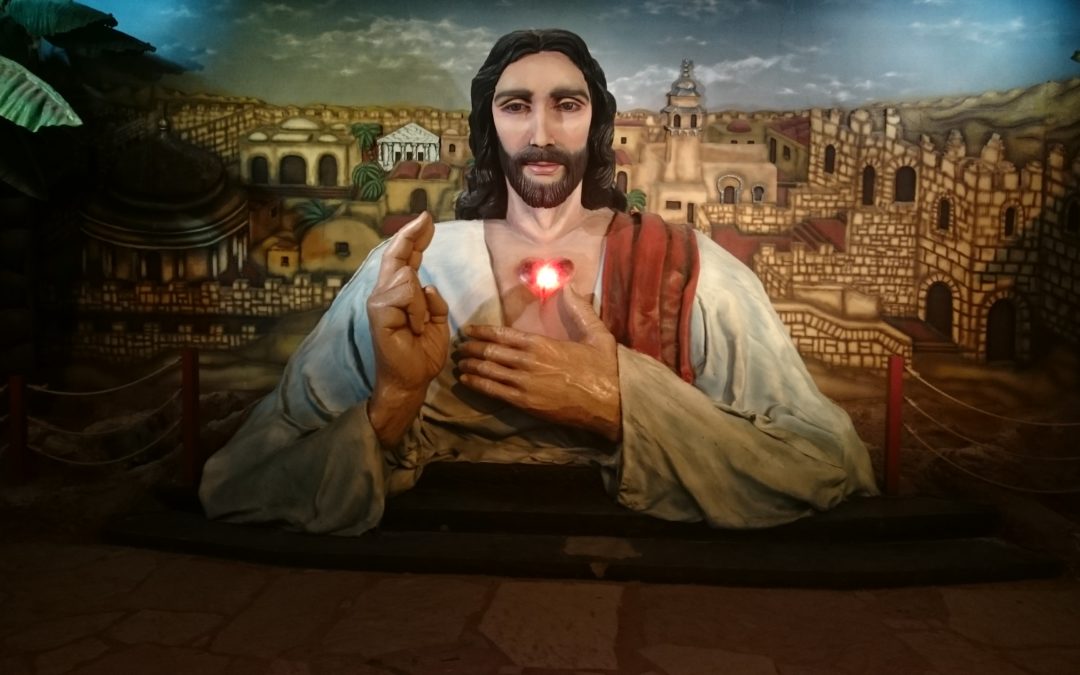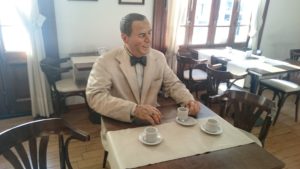Image 1: A hyperreal depiction of the Sacred Heart of Jesus at Tierra Santa. Credit: Brigid Lynch
By Brigid Lynch (CLACS)
23 March 2022 marked the second anniversary of the first UK lockdown in response to the Covid-19 pandemic. The lockdown and the restrictions that came with it represented a watershed moment in recent history, and its repercussions will continue to be felt for years to come, not least for those personally impacted by the virus. One of the major changes that successive recent lockdowns have brought about is in our relationship with work and leisure, and in how we use public leisure spaces. While the restrictions we experienced during successive pandemic lockdowns are gradually lifting, and holidays and international travel are now once again possible, public leisure attractions at home have become increasingly important in how we experience leisure and engage with others.
Theme parks and other immersive leisure spaces are an enduringly popular form of public recreation which invite us to explore discrete individual worlds in an enclosed and secure environment. Often using aesthetics of kitsch, miniaturisation and hyperreality, these attractions immerse the visitor in imagined landscapes of the past, present and future. As an inherently populist form of visitor attraction, theme parks are designed around the principles of public participation and consumption. Whilst characterizing these spaces as intrinsically conservative, several scholars highlight their latent capacity for cultural experimentation and resistance (Freitag 2017: 924). Indeed, North American theme parks have been described as both a mode of public art (Krause Knight 2008: 83) and sites of collective memory (Cross 2015: 203).
My current research project ‘Everyday Wonderlands: Theme Parks and Citizenship in Argentina and Beyond’ investigates the history of the theme park in Argentina. There, in contrast to the paradigmatic North American parks like Disneyland, these attractions have historically been conceived and constructed under the auspices of the state, either as part of civic initiatives of celebration or as spatial commemorations of the achievements of specific governments. By looking at attractions like La República de los niños in La Plata, the first ever theme park constructed in Argentina and opened in 1951, and the ill-fated Parque de la ciudad, which opened in 1982 in Buenos Aires during the dictatorship (1976-1983), my research explores how ideas of belonging and citizenship were represented in these leisure sites.
As state-sponsored leisure attractions, these theme parks offer a kind of hybrid experience, a mixture of the sensibilities of public national exhibitions and world fairs, and the conventions of the theme park. A central question here must be, given the centrality of a theme or narrative to themed spaces, when theme parks are owned and operated by the state, what are the stories that these spaces seek to tell, and what are the subjectivities of citizenship, belonging, and national identity that they evoke? Within the narratives of these themed and immersive spaces, how can the visitor locate themselves within these stories and engage with and re-evaluate personal and collective conceptions of identity?
The idea for this project first came to me when during a period of PhD fieldwork in Argentina in 2016. On a day off from research, I visited Tierra Santa, a biblical theme park located on the Costañera Norte, on the northern outskirts of Buenos Aires. This theme park is privately owned and first opened in 1999, the brainchild of the prolific artist and sculptor Fernando Pugliese. The first religious theme park in Latin America, Tierra Santa aims to transport its visitors to Jerusalem at the time of Christ, within a site of over seven hectares. Beginning with an animatronic depiction of the Nativity, the park depicts significant events from the life of Jesus in a space themed to resemble biblical Jerusalem, with streets, houses and marketplaces populated by over five hundred sculpted figures created by Pugliese.
The park’s highlight, and one of its most controversial attractions, is a forty-foot-high figure of the resurrected Christ that rises up from inside the Mount of Golgotha every half hour to a soundtrack of Handel’s Hallelujah Chorus (see Image 1). Kitsch is everywhere here, but as a positive and potent force that encourages the visitor to join in with the spectacle of the theme park, and to experience the sights, sounds, smells and feel of this artificial Jerusalem. One of the most striking things about Pugliese’s sculptures is their hyperreal and haptic nature. Made from sculpted polystyrene and concrete, the figures are lifelike yet obviously not human and it is this combination of strangeness and familiarity that arouses the desire to touch the sculptures and to feel their contours. Indeed, in other places throughout Buenos Aires, it is possible to do precisely this, since Pugliese’s sculptures seem to be everywhere: outside the theatres of the Avenida Corrientes, in cafes and restaurants, and in shopping centres across the city.
I came across one particularly striking example in the café of the Instituto Nacional Juan Domingo Perón, where Pugliese’s figure of the former president of Argentina sits at a table, mid-sip from his morning coffee, smiling invitingly at visitors to join him at one of the empty chairs that surround him (see Image 2). It was after this encounter that I started to think about the potential of themed and immersive spaces outside of the theme park, in places that we come across not as part of planned excursions or days out but in the course of our everyday lives. This led to the second strand of my current research, which looks at how other themed spaces were central to depictions of citizenship in Argentina during the Kirchner era (2003-2015), particularly during the 2010 Bicentenary year.
Derek Foster describes themed and immersive spaces as ‘sites of symbolic action, an environment filled with texts to be read and textures to be felt, […] places of cultural performance where popular culture is not simply read or interpreted but reinscribed’ (Foster 2016: 179). In interacting with these spaces, not only can we read the cultural texts within them, and feel their textures, but in the different ways we interact with these attractions, we are also able to play with our own ideas of belonging and identity and to reconfigure their meaning. Researching the significance of these spaces in Argentina has also helped me to think about how we engage with themed attractions at home.
This year, from March to October, the UK will host ‘Unboxed: Creativity in the UK’, a multimedia festival described as ‘a once-in-a-lifetime celebration of creativity taking place across England, Northern Ireland, Scotland, Wales and online’. Announcing the event in 2018 as ‘Festival UK 2022’, then-Prime Minister Theresa May described the festival as an opportunity for ‘a moment of national renewal’ in the wake of the country’s decision to leave the European Union, evoking parallels with the post-war optimism of the 1951 Festival of Britain. In a post-Brexit UK, where conflicting visions of national and regional identity increasingly compete for prominence, perhaps the Unboxed festival will offer us the chance to explore how we see ourselves, and how others see us.
References
Cross, Gary. 2015. Consumed Nostalgia. New York: Columbia University Press.
Foster, Derek. 2016. ‘Believe It or Not: The Playful Pull of Culture-Themed Tourism Attractions’. In Scott. A Lukas. A Reader in Themed and Immersive Spaces. Pittsburgh: Etc Press, pp. 173-182.
Freitag, Florian. 2017. ‘Critical Theme Parks: Dismaland, Disney and the Politics of Theming’, Continuum 31: 923–932.
Krause Knight, Cher. 2008. Public Art: Theory, Practice and Populism. Oxford: John Wiley & Sons.
Acknowledgements
This research is funded by a Postdoctoral Research Award from the Society of Latin American Studies.
Author
Brigid Lynch (@LynchCBrigid) is Visiting Fellow at the Centre for Latin American and Caribbean Studies (CLACS), which is part of the Institute of Modern Languages Research at the School of Advanced Study, University of London.
Disclaimer
The views expressed in this article are the author’s own and do not necessarily represent the position of CLACS or the School of Advanced Study, University of London.



Recent Comments